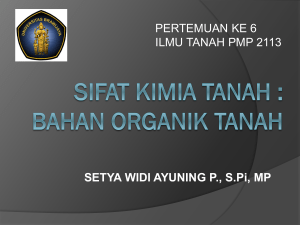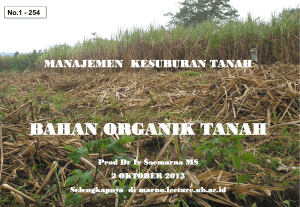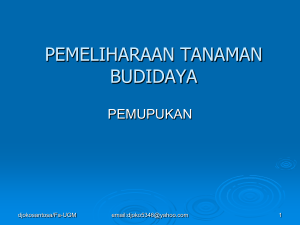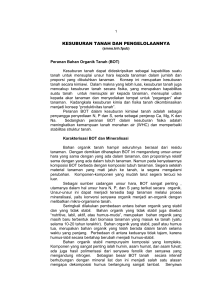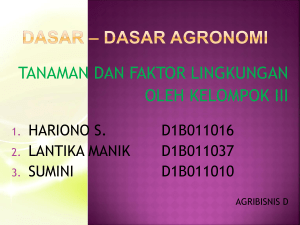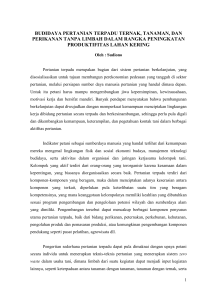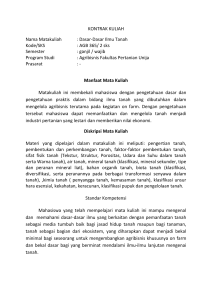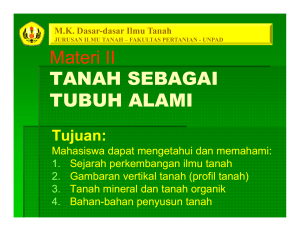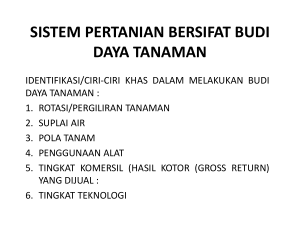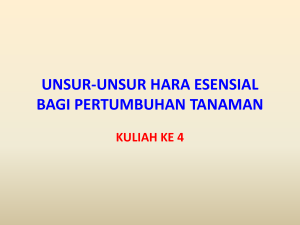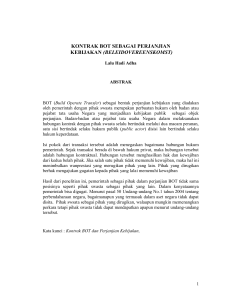pengelolaan bot dan humus tanah
advertisement
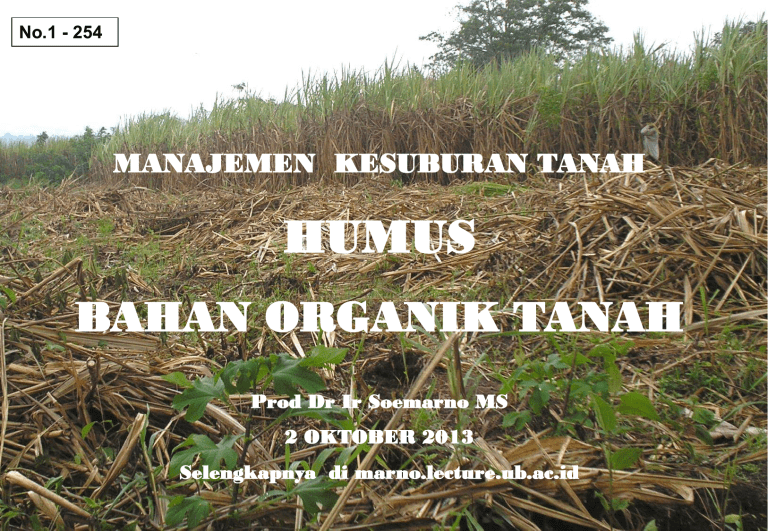
No.1 - 254 MANAJEMEN KESUBURAN TANAH HUMUS BAHAN ORGANIK TANAH Prod Dr Ir Soemarno MS 2 OKTOBER 2013 Selengkapnya di marno.lecture.ub.ac.id KONSEP FLAIG ttg PEMBENTUKAN HUMUS Lignin, YANG DIBEBASKAN DARI IKATANNYA DNEGAN SELULOSE selama proses dekomposisi bahan organik, akan mengalami reaksi pemecahan oksidatif menjadi unit-unit strukturalnya (derivasi dari phenyl-propane). Rantai samping dari unit-unit lignin ini selanjutnya dioksidasi, terjadi proses demethylasi, dan menghasilkan poli-fenol. Selanjutnya poli-fenol ini diubah menjadi quinone dengan bantuan ensim poly-phenol-oxidase. Quinone ini bereaksi dengan senyawa yang mengandung N membentuk polimer yang berwarna gelap. Peran mikroba tanah dalam pembentukan poli-fenol sangat penting. Substansi humik dibentuk oleh bakteri dekomposisi selulose ( myxobacteria) sebelum dekomposisi lignin. KONSEP FLAIG ttg PEMBENTUKAN HUMUS Fase-fase pembentukan substansi humik dirumuskan sbb: Fungi menyerang karbohidrat sederhana dan bagianbagian dari protein dan selulose yang ada dalam bahan organik residu tumbuhan. Sellulose dari xylem di-dekomposisikan oleh myxobacteria aerobik. Poly-phenols yang disintesis oleh myxobacteria dioksidasi menjadi quinones oleh ensim-ensim polyphenol-oxidase , dan selanjutnya quinones bereaksi dengan senyawa N membentuk substansi humik yang berwarna coklat. Lignin mengalami dekomposisi. Phenol yang dilepaskan selama dekomposisi juga berfungsi sebagai sumber material untuk sintesis humus. FUNGSI BOT BOT tanah mempunyai beberapa fungsi penting: FUNGSI NUTRISI, BOT berfungsi sebagai sumber N, P, S untuk pertumbuhan tanaman FUNGSI BIOLOGIS, BOT mempengaruhi aktivitas mikro-flora & mikro-fauna tanah FUNGSI FISIK & FISIKO-KIMIA, memacu pembentukan struktur tanah yg baik , memperbaiki sifat olah tanah, aerasi & penyimpanan air, meningkatkan daya penyangga & kapasitas pertukaran . Humus juga mampu membantuk efisiensi aplikasi unsur mikro, pestisida dan bahan agrokimia lainnya. BOT & KETERSEDIAAN HARA BOT MEMPUNYAI EFEK LANGSUNG & TIDAK LANGSUNG thd ketersediaan hara bagi tanaman . BOT berfungsi juga sebagai sumber hara N, P, S melalui proses mineralisasi oleh mikroba tanah. BOT juga mempengaruhi suplai hara dari sumber lain, (misalnya BOT diperlukan sebagai sumber energi bagi bakteri fiksasi N). Kalau tanah baru dibuka dan diolah, kandungan humus akan menurun selama periode 10 - 30 tahun hingga tercapai kesetimbangan baru. Pada kondisi kesetimbangan ini, unsur hara yang dibebaskan oleh aksi-aksi mikroba tanah harus diimbangi dengan sejumlah masukan yang sama ke dalam sistem-humus. EFEK BOT thd KONDISI FISIK TANAH, EROSI TANAH & EFEK PENYANGGA & KAPASITAS PERTUKARAN ION Humus mempunyai efek yg bagus thd struktur tanah. Kerusakan struktur tanah akibat pengolahan tanah yg intensif biasanya tidak terlalu parah pada tanah yang kaya BOT. Kalau humus hilang, tanah akan menjadi keras, kompak dan menggumpal. Aerasi, daya simpan air dan permeabilitas, semuanya diperbaiki oleh adanya humus. Penambahan residu bahgan organik segar yang mudah-lapuk mengakibatkan sintesis senyawa organik-kompleks yang mampu mengikat partikel-partikel tanah menjadi agregat. Agregasi seperti ini membantuk tanah menjadi longgar, terbuka, dan granuler; sehingga air dapat menembus lapisan tanah yg lebih dalam. Pori yang besar dalam tanah juga memacu pertukaran gas antara udara tanah dengan atmosfer. EFEK BOT thd KONDISI FISIK TANAH, EROSI TANAH & EFEK PENYANGGA & KAPASITAS PERTUKARAN ION Humus mampu meningkatkan kemampuan tanah untuk melawan erosi. Humus, memungkinkan tanah menyimpan lebih banyak air. Even more important is its effect in promoting soil granulation and thus maintaining large pores through which water can enter and percolate downward. From 20 to 70% of the exchange capacity of many soils is caused by colloidal humic substances. Total acidities of isolated fractions of humus range from 300 to 1400 meq/100g. Humus juga mempunyai kemampuan untuk menyangga fluktuasi kisaran pH yang luas. EFEK BOT PADA BIUOLOGI TANAH Bahan organik berfungsi sebagai sumber energi bagi organisme makro dan mikro. Numbers of bacteria, actinomycetes and fungi in the soil are related in a general way to humus content. Earthworms and other faunal organisms are strongly affected by the quantity of plant residue material returned to the soil. Substansi organik dalam tanah juga mempunyai efek fisiologis langsung thd pertumbuhan tanaman . Senyawa asam-asam fenolat, mempunyai sifat phyto-toksik ; sedangkan senyawa auksin, bersifat dapat memacu pertumbuhan tanaman . EFEK BOT PADA BIUOLOGI TANAH Faktor-faktor yang mempengaruhi kejadian organisme patogenik dalam tanah ternyata dipengaruhi oleh bahan organik. Misalnya, ketersediaan BOT yang mencukupi dapat memacu pertumbuhan organisme saprofitik yang memusuhi organisme parasitik, sehingga populasi parasitik ini berkurang. Biologically active compounds in soil, such as antibiotics and certain phenolic acids, may enhance the ability of certain plants to resist attack by pathogens. Kandungan humus pada horison akumupasi tanah-tanah utama di Polandia (Turski, 1996) Division and order Type,genera and kind Humus content % 1.9 Grey brown soils formed from silt formations 1.4 - 2.4 Luvisols: Grey brown soils formed from loess and loesslike materials 1.8 1.0 - 2.5 1.6 Grey brown soils formed from light loam 1.0 - 2.6 1.5 Podzols: Podzolic soil formed from sands 1.1 - 2.0 1.6 Gleysols: Boggy soils formed from silts 1.2 - 2.1 Kandungan humus pada horison akumupasi tanah-tanah utama di Polandia (Turski, 1996) Division and order Type,genera and kind Black earth formed from sands Gleysols: Black earth formed from light and medium loams Black earth formed from heavy loams and clays Alluvial soils formed from sands Fluvisols: Alluvial soils formed from silts Alluvial soils formed from clays Humus content % 2.8 1.2 - 4.1 2.6 1.2 - 5.7 4.9 2.5 - 5.6 2.9 1.5 - 5.2 3.5 1.7 - 5.8 4.2 2.4 - 6.8 Kandungan humus pada horison akumupasi tanah-tanah utama di Polandia (Turski, 1996) Division and order Calcisols: Type,genera and kind Calcarious Rendzinas Jurasic Rendzinas Phaeozems: Haplic Phaeozems Brown soils formed from sands Brown soils formed from light and medium loams Cambisols: Brown soils formed from heavy loam Brown soils formed from silt formations Brown soils formed from loess and loesslike materials Humus content % 3.4 2.1 - 6.3 4.4 1.5 - 7.0 2.8 1.8 - 4.0 1.5 0.9 - 2.2 1.8 1.1 - 3.0 2.5 1.6 - 3.7 1.7 1.3 - 1.9 1.9 1.4 - 2.6 Kadar Humus Tanah Kandungan humus tanah dipengaruhi oleh faktorfaktor: 1. amount and quality of humus, which get at soil in given bioecological zone 2. tempo of humification process of organic matter 3. tempo of mineralization of humus, which is contain in soil 4. Sifat-sifat kimia, fisika, dan fisiko-kimia tanah 5. Jumlah dan kualitas senyawa-senyawa mineral dalam tanah BOT & PRODUKTIVITAS TANAMAN Para ahli pertanian telah mengenali pentiungnya manfaat BOT bagi produktivitas tanaman. Many of the benefits of SOM have been well documented scientifically, but some effects are so intimately associated with other soil factors that it is difficult to ascribe them uniquely to the organic matter. In fact, soil is a complex, multicomponent system of interacting materials, and the properties of soil result from the net effect of all these interactions. One of the major problems in communicating in the field of humic substances is the lack of precise definitions for unambiguosly specifying the various fractions. Unfortunately, the terminology is not used in a consistent manner. The term humus is used by some soil scientists synonymously with soil organic matter, that is to denote all organic material in the soil, including humic substances. BOT & KOMPOSISINYA Istilah BOT lazimnya digunakan untuk menyatakan komponen organik dalam tanah , termasuk sisa-sisa tumbuhan dan hewan yg belum terlapuk, hasil-hasil dekomposisinya, dan biomasa tanah. Sehingga BOT mencakup material organik yg teridentifikasi bobot molekulnya besar, seperti poli-sakarida dan protein; Senyawa organik sederhana seperti gula, asam amino, dan senyawa organik lain yg bobot molekulnya kecil. It is likely that SOM contains most if not all of the organic compounds synthesized by living organisms. SOM is frequently said to consist of humic substances and nonhumic substances. Nonhumic substances are all those materials that can be placed in one of the categories of discrete compounds such as sugars, amino acids, fats and so on. Humic substances are the other, unidentifiable components. Even this apparently simple distinction, however, is not as clear cut as it might appear. BOT & KOMPOSISINYA Senyawa Organik Tanah - live organisms and their undecomposed, partly decomposed and completely decomposed remains as well as products of their transformation. Living organisms alive - edaphon. Bahan Organik Tanah - non-living components which are a heterogeneous mixture composed largely of products resulting from microbal and chemical transformations of organic debris. Soil organic matter can exist in different morphological patterns, which are the bases of the classification of so called forms and types of humus. Material Segar - fresh and non-transformed components of older debris. HUMUS & SUBSTANSI HUMIK Hasil-hasil Dekomposisi - (humus) - bearing no morphological resemblance to the structures from which they were derived. These transformed components are reffered to as the humification process products. Substansi Humik - a series of relativelyhigh-molecular-weight, brown to black colored substances formed by secondary synthesis reactions. The term is used as a generic name to describe to colored material or its fractions obtained on the basis of solubility characteristics: Asam Humat (HA) Asam Fulvat (FA) Humin. BOT & SUBSTANSI NONHUMIK Substansi Non-humik compounds belonging to known classes of biochemistry, such as: Karbohydrat Lemak Asam amino. TIPE & BENTUK BOT Senyawa organik dalam tanah Tipe & Bentuk BOT Bahan organik tanah Produk transformasi (Humus) Substansi Non-Humik Substansi Humik Partikel Mineral Humus stabil 70-90% Tanah Bahan Organik Tanah (BOT) Biomasa Mikroba tanah KOMPONEN-KOMPONEN BOT Fiksasi atmosferik / Produksi Pupuk Gas N2 78% atmosfir Fiksasi Nitrogen Panen Tanaman Residu tanaman & ternak N dalam BOT Amonium NH4+ Serapan Tanaman Erosi & runoff Nitrat NO3- Denitrifikasi Pencucian ke groundwater PERANAN BOT DALAM SIKLUS NITROGEN MENGAPA BAHAN ORGANIK SANGAT PENTING? Bahan organik terlibat dalam berbagai peran-kunci untuk memacu pertumbuhan tanaman. BO juga sangat penting dalam hubungannya dnegan siklus global dan regional. A fertile soil is the basis for healthy plants, animals, and humans. Soil organic matter is the very foundation for healthy and productive soils. Understanding the role of organic matter in maintaining a healthy soil is essential for developing ecologically sound agricultural practices. MENGAPA BAHAN ORGANIK SANGAT PENTING? Kandungan BOT tanah lapisan atas lazimnya berkisar antara 1 hingga 6 persen. A study of soils in Michigan demonstrated potential cropyield increases of about 12 percent for every 1 percent organic matter. Hasil-hasil penelitian menunjukkan bahwa hasil jagung meningkat sekitar 80 bushels per acre, kalau BOT ditingkatkan dari 0.8 menjadi 2 persen. Aktivitas biologis & Diversitas meningkat Penambahan bahan organik Penyakit tanah, Nematoda parasitis berkurang Perbaikan struktur pori Agregasi meningkat Humus dan Zat tumbuh lainnya Dekomposisi bahan organik Hara dilepaskan Detoksifikasi Substansi berbahaya Perbaikan sifatolah dan Simpanan air TANAMAN SEHAT Penambahan bahan organik ke tanah akan mengakibatkan berbagai perubahan BOT & HARA TANAMAN Tanaman memerlukan 18 unsur hara esensial untuk pertumbuhannya: carbon (C), hydrogen (H), oxygen (O), nitrogen (N), phosphorus (P), potassium (K), sulfur (S), calcium (Ca), magnesium (Mg), iron (Fe), manganese (Mn), boron (B), zinc (Zn), molybdenum (Mo), nickel (Ni), copper (Cu), cobalt (Co), and chlorine (Cl). Plants obtain carbon as carbon dioxide (CO2) and oxygen partially as oxygen gas (O2) from the air. Unsur hara esensial ini diperoleh tanaman dari tanah . Ketersediaan unsur hara dalam tanah snagat dipengaruhi oleh adanya bahan organik. The elements needed in large amounts carbon, hydrogen, oxygen, nitrogen, phosphorus, potassium, calcium, magnesium, sulfur are called macronutrients. Unsur hara mikro dibutuhkan tanaman dalam jumlah sedikit. UNSUR HARA DARI DEKOMPOSISI BOT. Unsur hara dalam BOT tidak dapat digunakan oleh tanaman selama masih dalam bentuk molekul organik yang besar-besar. As soil organisms decompose organic matter, nutrients are converted into simpler, inorganic, or mineral forms that plants can easily use. This process, called mineralization, provides much of the nitrogen that plants need by converting it from organic forms. For example, proteins are converted to ammonium (NH4+) and then to nitrate (NO3-). Kebanyakan tanaman akan menyerap nitrogen dari tanah dalam bentuk nitrat dan ammonium. Mineralisasi BOT juga merupakan mekanisme penting dalam mensuplai unsur hara bagi tanaman , seperti N, P dan S, serta unsur hara mikro. Siklus hara tanaman Ternak Tanaman tumbuh Residu tanaman & Pupuk kandang Bahan Organik Tanah BOT & PENAMBAHAN NITROGEN TANAH Bacteria yang hidup dalam bintil akar tanaman legume mampu mengubah nitrogen (N2) dari atmosfer menjadi bentuk senyawa yang dapat digunakan oleh tanaman secara langsung. There are a number of free-living bacteria that also fix nitrogen. BOT & PENYIMPANAN HARA BO yang mengalami dekomposisi dapat memberi makanan langsung ke tanaman, tetapi ia juga dapat memberi keuntungan secara tidak langsung pada nutrisi tanaman . Bahan organik mempunyai kemampuan menjerap kation dan masih tersedia bagi tanaman, BO punya Kapasitas Tukar Kation (KTK) yang sangat besar. Humus mempunyai banyak muatan negatif , sehingga mampu mengikat kation-kation seperti Ca++, K+, dan Mg++ . This keeps them from leaching deep into the subsoil when water moves through the topsoil. Nutrients held in this way can be gradually released into the soil solution and made available to plants throughout the growing season. However, keep in mind that not all plant nutrients occur as cations. Misalnya, anion nitrate bermuiatan negatif (NO3-) dan ditolak oleh koloid tanah (KTK) yang bermuatan negatif. Oleh karena itu, nitrat mudah tercuci dalam air yang bergerak melalui masa tanahke luar zone akar tanaman. Kation yang diikat humus Kation yang diikat Partikel Liat Kation yang diikat khelat organik Kation-kation yang ditahan (diikat) pada bahan organik dan pada partikerl liat BAHAN ORGANIK DAN SIKLUS-SIKLUS ALAMI SIKLUS KARBON BOT mempunyai peranan penting dalam siklus karbon secara global. Siklus karbon menjadi semakin penting karena akumulasi CO2 dalam atmosphere dianggap sebagai penyebab terjadinya PEMANASAN GLOKAL . Co2 juga dilepaskan ke atmosfer pada saat membakar bahan bakar, seperti gas, minyak, dan kayu. A simple version of the natural carbon cycle, showing the role of soil organic matter, is given in figure 4.6. Carbon dioxide is removed from the atmosphere by plants and used to make all the organic molecules necessary for life. Fotosintesis Panen Tanaman Karbon dalam BOT Erosi & Runoff Peranan bahan organik tanah dalam siklus karbon. Kehilangan karbon dari lahan dapat terjadi melalui respirasi tanaman, dekomposisi BOT, Panen tanaman dan Erosi. BOT & SIKLUS NITROGEN Bahan organik tanah juga mempunyai peranan sangat penitng dalam siklus nitrogen . Siklus N ini sangat penting dalam pertanian, karena biasanya kandungan N-tersedia dalam tanah sangat terbatsa. The nitrogen cycle and soil organic matter enters into the cycle. Some bacteria living in soils are able to "fix" nitrogen, converting nitrogen gas to forms that other organisms, including crop plants, can use. Inorganic forms of nitrogen, like ammonium and nitrate, exist in the atmosphere naturally, although air pollution causes higher amounts than normal. Rainfall and snow deposit inorganic nitrogen forms on the soil. Inorganic nitrogen also may be added in the form of commercial nitrogen fertilizers. These fertilizers are derived from nitrogen gas in the atmosphere through an industrial fixation process. Bacteria dan fungi mengubah N-organik menjadi ammonium dan bacteria lainnya mengubah ammonium menjadi nitrat. Nitrat dan ammonium keduanya dapat diserap oleh akar tanaman. Gas N2 (78% atmosfir Fiksasi atmosferik atau Produksi pupuk N Fiksasi Nitrogen Volatilisasi Panen tanaman Residu tanaman dan ternak N dlm BOT Serapan tanaman NH4+ (ammonium) NO3(Nitrat) Pencucian ke Groundwater Peranan bahan organik tanah dlaam siklus nitrogen. Kehilangan N dari lahan dapat terjadi melalui proses penguapan, panen tanaman, Erosi tanah, Denitrifikasi, dan Pencucian BOT , SIKLUS HARA & KESUBURAN TANAH Ada sekitar 18 unsur hara esensial bagi pertumbuhan tanaman. C, H, dan O, diperoleh tanaman dari udara dan air. N, P, K, Ca, Mg, S, Fe, Mn, Zn, Cu, B, Mo, dan Cl diperoleh tanaman dari dalam tanah. Semua unsur hara esensial sama pentingnya bagi kesehatan pertumbuhan tanaman, tetapi ada p[erbedaan jumlah yang dibutuhkannya. N, P, and K are primary macronutrients with crop requirements generally in the range of 50-150 lb. per acre. Ca, Mg, and S are secondary macronutrients, required in amounts of 10-50 lb. per acre. Kebutuhan unsur mikro (Fe, Mn, Zn, Cu, B, Mo, dan Cl) biasanya BOT & SIKLUS HARA Sumber unsur hara dalam tanah adalah: 1. Pelapukan mineral tanah, 2. decomposition of plant residues, animal remains, and soil microorganisms, 3. application of fertilizers and liming materials, \ 4. application of manures, composts, biosolids (sewage sludge) and other organic amendments, 5. Fiksasi N oleh legume, 6. ground rock powders or dusts including greensand, basalt, and rock phosphate, 7. Limbah industri anorganik 8. Deposisi atmosferik, seperti N dan S dari hujan asam atau fiksasi-N oleh radiasi 9. Deposisi sedimen kaya hara dari erosi dan banjir. BOT & SIKLUS HARA Kehilangan hara dari tanah: 1. Runoff / LIMPASAN PERMUKAAN - loss of dissolved nutrients in water moving across the soil surface, 2. EROSI - loss of nutrients in or attached to soil particles that are removed from fields by wind or water movement, 3. PENCUCIAN - loss of dissolved nutrients in water that moves down through the soil to groundwater or out of the field through drain lines, 4. Gaseous losses to the atmosphere - primarily losses of different N forms through volatilization and denitrification, and 5. PANEN TANAMAN - plant uptake and removal of nutrients from the field in harvested products. BOT & CADANGAN HARA DALAM TANAH Cadangan hara dlaam tanah dapat berbentuk hara-terlarut, hara mudah-tersedia, hara terikat-lemah dan berkesetimbangan dengan hara-terlarut, hara yg terikat kuat atau bentuk yg mengendap, tidak dapat larut, dan hanya tersedia bagi tanaman dalam jangka panjang. Nutrients in solution can be taken up immediately by plant roots, but they also move with water and can easily leach below the plant root zone or be lost from farm fields. The ideal fertile soil has high nutrient concentrations in the soil solution when crop growth rates are high, but a large storage capacity to retain nutrients when crop needs are low or there is no growing crop. BOT & CADANGAN HARA DALAM TANAH Kation tukar merupakan cadangan hara yang berkesetimbangan dnegan hara-terlarut. Soil organic matter releases nutrients slowly as it decomposes, but is an important supply of N, P, S, and micronutrients. Soil minerals and precipitates vary from fairly soluble types (carbonates, sulfates, chlorides) in equilibrium with the soil solution to rather insoluble forms (feldspars, apatite, mica) that release nutrients through reactions with chemical agents such as organic acids. Adsorbed anions, such as phosphate and iron oxides bound to clay and organic matter surfaces, are held strongly and released very slowly, but can contribute to the long-term supply of plant-available nutrients. BOT & KTK TANAH Partikel liat dan bahan organik mempunyai tapak yg bermuatan negatif, yang dapat mengikat kation pd permukaannya. KTK melindungi ion-ion terlarut sehingga tidak tercuci dan hilang dari zone perakaran tanaman. Ion-ion ini dengan cepat dapat bertukar-tempat dengan ion-ion terlarut, sehingga kalau akar menyerap ion terlarut maka ion-tukar ini dnegan cepat akan memperbarui ion-ion terlarut. Pertukaran kation merupakan sumber utama unsur hara K+, Ca2+, Mg2+, dan NH4+ , serta unsur mikro Zn2+, Mn2+, dan Cu2+ BOT & KTK TANAH Bahan organik tanah merupakan cadangan hara tanaman, ia mempunyai nilai KTK yang besar, mampu menyangga perubahan pH tanah , dan membentuk khelate unsur mikro. Berbagai bentuk bahan organik berada dlaam tanah, mulai dari organisme hidup, residu tumbuhan yg mudah terlapuk, hingga humus yang sangat stabil dan tahan terhadap pelapukan. Daur ulang hara tanaman melalui bahan organik tanah mampu mensuplai sejumlah besar hara yg dibutuhkan tanaman. Stable humus is the organic matter fraction that has a high CEC. Cation exchange helps soils resist changes in pH in addition to retaining plant nutrients. Chelation is the ability of soluble organic compounds to form complexes with micronutrient metals that keep them in solution and available for uptake. BOT & SIKLUS Nitrogen Siklus Nitrogen merupakan siklus unsur hara yang sangat kompleks. Berbagai bentuk senyawa N, sehingga transformasi di antara bentukbentuk ini mengakibatkan siklus N merupakan proses yang sangat kompleks. Chemical transformations of N, such as nitrification, denitrification, mineralization, and N-fixation are performed by a variety of soil-inhabiting organisms. Physical transformations of N include several forms that are gases which move freely between soil and the atmosphere. Although the Ncycle is very complex, it is probably the most important nutrient cycle to understand. Ada dua alasan penting, yaitu: 1) N biasanya menjadi faktopr pembatas bagi pertumbuhan tanaman dalam ekosistem darat, sehingga seringkali hasil tanaman sangat respon terhadap pemupukan N, dan 2) N-nitrat dalam tanah sangat mudah larut dan sangat mobil, sehingga mudah hilang dari lahan dan menjadi pencemar di perairan permukaan dan groundwater. Pengelolaan N menjadi magian yang kritis dari “Pengelolaan Kesuburan Tanah”. BOT & KESUBURAN TANAH Praktek pengelolaan untuk memaksimumkan siklus unsur hara dan efisiensi penggunaan hara. Nutrient management is defined as the efficient use of all nutrient sources and the primary challenges in sustaining soil fertility are to: 1. Mereduksi kehilangan hara, 2. Memelihara atau meningkatkan kapasitas simpanan hara 3. Memacu daur-ulang unsur hara tanaman. Praktek budidaya tanaman yang mendukung pertumbuhan perakaran yang sehat dan vigorous-root akan mengakibatkan penyerapan dan pemanfaatan unsur hara tersedia secara lebih efisien. BOT & KESUBURAN TANAH Banyak praktek pengelolaan dapat memacu perakaran yang sehat, including establishing diverse crop rotations, growing cover crops, reducing tillage, managing & maintaining crop residue, handling manure as a valuable nutrient source, composting & using all available wastes, liming to maintain soil pH, applying supplemental fertilizers, and routine soil testing. Praktek pengelolaan yang baik ini mempunyai efek ganda pada kesuburan tanah, …… ….. which makes it important to integrate their use and examine their effects on the complete soil-crop system rather than just a single component of that system. PERGILIRAN TANAMAN & BOT Growing a variety of crops in sequence has many positive effects. In a diverse rotation, deep-rooted crops alternate with shallower, fibrous-rooted species to bring up nutrients from deeper in the soil. This captures nutrients that might otherwise be lost from the system. Including sod crops in rotation with row crops decreases nutrient losses from runoff and erosion and increases soil organic matter. Growing legumes to fix atmospheric N reduces the need for purchased fertilizer and increases the supply of N stored in soil organic matter for future crops. Biologically-fixed N is used most efficiently in rotations where legumes are followed by crops with high N requirements. Pergiliran tanaman juga meningkatkan biodiversitas tanah dengan menyediakan beragam jenis residu organik dan sumber makanan, mereduksi gangguan patogen tanah , dan menciptakan kondisi lingkungan tumbuh yang sesuai bagi perakaran yang sehat. TANAMAN PENUTUP TANAH & BOT Penanam tanaman penutup-tanah dapat dianggap sebagai perluasan dari pola pergiliran tanaman dan menyediakan manfaatmanfaat yang sama. Menanam legume penutup-tanah berarti menambah N hasi fiksasi biologis ke dalam tanah. The additional plant diversity with cover crops stimulates a greater variety of soil microorganisms, enhances carbon and nutrient cycling, and promotes root health. The soil surface is covered for a longer period of time during the year, so nutrient losses from runoff and erosion are reduced. Periode pertumbuhan tanaman yang lebih lama akan meningkatkan penangkapan energi matahari, dan produksi biomasa tanaman meningkat, yang selanjutnya dapat meningkatkan jumlah biomasa yang dikembalikan ke tanah. TANAMAN PENUTUP TANAH & BOT Bahan organik merupakan cadangan energi dalam tanah, cadangan unsur hara, dan merupakan sumber makanan dan energi untuk organisme tanah. The extended growth period obtained with cover crops also extends the duration of root activity and the ability of root-exuded compounds to release insoluble soil nutrients. A winter cover crop traps excess soluble nutrients not used by the previous crop, prevents them from leaching, and stores them for release during the next growing season. Tanaman Penutup tanah juga dapat menekan gangguan gulma, sehingga mengurangi tingkat persaingan untuk hara tersedia dalam tanah. BOT & KONSERVASI TANAH-AIR Erosi tanah mengankut material topsoil, yang kaya bahan organik dan unsur hara tanaman. KOnservasi tanah dan air dapat menekan kehilangan hara dan menjaga kesuburan – produktivitas tanah. Tillage practices and crop residue cover, along with soil topography, structure, and drainage are major factors in soil erosion. Surface residue reduces erosion by restricting water movement across the soil and tillage practices determine the amount of crop residue left on the surface. Reduced tillage or no-till maximize residue coverage. Water moves rapidly and is more erosive on steep slopes, so reducing tillage, maintaining surface residue, and planting on countour strips across the slope are recommended conservation practices. BOT & KONSERVASI TANAH-AIR Pergiliran tanaman dan tanaman penutup tanah juga mampu mereduksi erosi tanah. Soils with stable aggregates are less erosive than those with poor structure and organic matter helps bind soil particles together into aggregates. Tillage breaks down soil aggregates and also increases soil aeration, which accelerates organic matter decomposition. Well-drained soils with rapid water infiltration are less subject to erosion, because water moves rapidly through them and does not build up to the point where it moves across the surface. Drainage improvements on poorly drained soils reduce erosion. Improving drainage also decreases N losses from denitrification, which can be substantial on waterlogged soils, by increasing aeration. BOT & PENGELOLAAN RABUK KANDANG Mengembalikan pupuk kandang ke lahan berarti mendaur-lang sejumlah besar hara yang hilang bersama panen tanaman. Unsur hara terlarut mudah tercuci dari pupuk kandang, terutama kalau tidak dilindungi dari air hujan selama penyimpanannya. Nitrogen juga mudah hilang melalui epenguapoan amonia, baik selama penyimpanan pupuk kandang maupun pada saat aplikasinya di lahan dengan dosis tinggi. Selain nilai haranya, pupuk kandang mampu menambahkan bahan organik ke tanah dan memberikan manfaat lain seperti peningkatan KTK tanah. BOT & KOMPOS In addition to manure, organic amendments such as biosolids (sewage sludge), food processing wastes, animal byproducts, yard wastes, seaweed, and many types of composted materials are nutrient sources for farm fields. Composting is a decomposition process similar to the natural organic matter breakdown that occurs in soil. Composting stabilizes organic wastes and the nutrients they contain, reduces their bulk, and makes transportation and field application of many waste products more feasible. Banyak material organik dapat dikomposkan , bahan-bahan ini mengandung unsur hara tanaman , dan mendaur-ulang bahanbahan organik ini melalui proses pengkomposan atau aplikasi langsung ke lahan sangat bermanfaat. Praktek budidaya seperti ini dapat meningkatkan BOT dan menyediakan sumber hara dalam jangka panjang yang dilepaskan secara lambat. BOT & SISTEM PERAKARAN YANG SEHAT Sistem perakaran yang bagus mampu menyerap unsur hara dari volume tanah yang lebih besar, sehingga praktek pengelolaan yang memacu pertumbuhan akar akan dapat meningkatkan serapan hara dari tanah. Sistem perakaran yang ekstensif dan menyebar merata dalam tanah dapat meningkatkan efisiensi penyerapan hara, karena semakin luasnaya permukaan akar yang kontak dnegan tanah. The extent of root-soil contact is only about 1-2% of total soil volume, even in the surface 6-inch layer of soil where root density is greatest. For immobile nutrients like phosphorus, root growth to the nutrient is very important. Dalam kebanyakan tanah, anion fosfat hanya mampu bergerak menempuh jarak beberapa millimeter ke arah permukaan akar tanaman, selama periode pertumbuhan tanaman. BOT & SISTEM PERAKARAN YANG SEHAT Luas permukaan kontak antara tanah dan akar ditentukan oleh panjang akar, percabangan akar, dan bulu-bulu akar. Bulu-bulu akar terletak di belakang ujung akar , dan umurnya sangat pendek, beberapa hari hingga beberapa minggu. Actively growing feeder roots are necessary to continually renew these important locations for nutrient uptake. Nutrient absorbing capacity is also increased by symbiotic associations between soil fungi and plant roots. These fungi, called mycorrhizae, function as an extension of plant root systems. Mycorrhizae obtain food from plant roots and in return increase the nutrient absorbing surface for the plant through their extensive network of fungal strands. Mycorrhizae sangat penting dalam penyerapan fosfat dan dapat juga meningkatkan serapan Zn dan Cu. BOT & SISTEM PERAKARAN YANG SEHAT Aktivitas akar tanaman juga berpengaruh langsung thd ketersediaan hara dlaam tanah. Insoluble nutrients are released and maintained in solution by the action of organic acids and other compounds produced by roots. Nutrients are also released because the soil immediately adjacent to roots, the rhizosphere, often has a lower pH than the bulk soil around it as a consequence of nutrient uptake. The rhizosphere stimulates microbial activity and microbes also release organic acids and other compounds that solubilize nutrients. BOT & SISTEM PERAKARAN YANG SEHAT Faktor tanah dan pengelolaannya dapat mempengaruhi pertumbuhan akar, distribusi akar dan kesehatan akar. Lapisan tanah yg padat membatasi penetrasi akar, pH rendah dalam subsoil dapat menghambat pertumbuhan akar, kejenuhan air dan aerasi yg jelek menghambat pertumbuhan akar, dan akan tidak akan tumbuh ke dalam zone tanah kering. Alleviating these conditions through some of the management practices described above can increase nutrient uptake. Cultural practices that maintain soil biodiversity promote healthy root systems, since an active and diverse microbial population competes with root pathogens and reduces root disease. PENGELOLAAN KESUBURAN TANAH: PENDEKATAN KIMIA DAN BIOLOGIS Tujuan pengelolaan hara yang efektif adalah menyediakan cukup hara guna pertumbuhan yg optimum dan kualitas hasil panen yg baik, dan pada saat yg sama juga meminimumkan pergerakan unsur hara ke luar dari zone perakaran tanaman. Biological processes in the soil control nutrient cycling and influence many other aspects of soil fertility. Knowledge of these important processes helps farmers make informed management decisions about their crop and livestock systems. How these decisions affect soil biology, especially microbial activity, root growth, and soil organic matter are key factors in efficient nutrient management. PENGELOLAAN KESUBURAN TANAH: PENDEKATAN KIMIA DAN BIOLOGIS Managing soil organic matter and biological nutrient flows is complex because crop residues, manures, composts, and other organic nutrient sources are variable in composition, release nutrients in different ways, and their nutrient cycling is strongly affected by environmental conditions. Proses-proses kimia dalam tanah dapat mengendalikan kelarutan mineral , pertukatan kation, pH, dan penjerapan kation ke permukaan partikel tanah.
